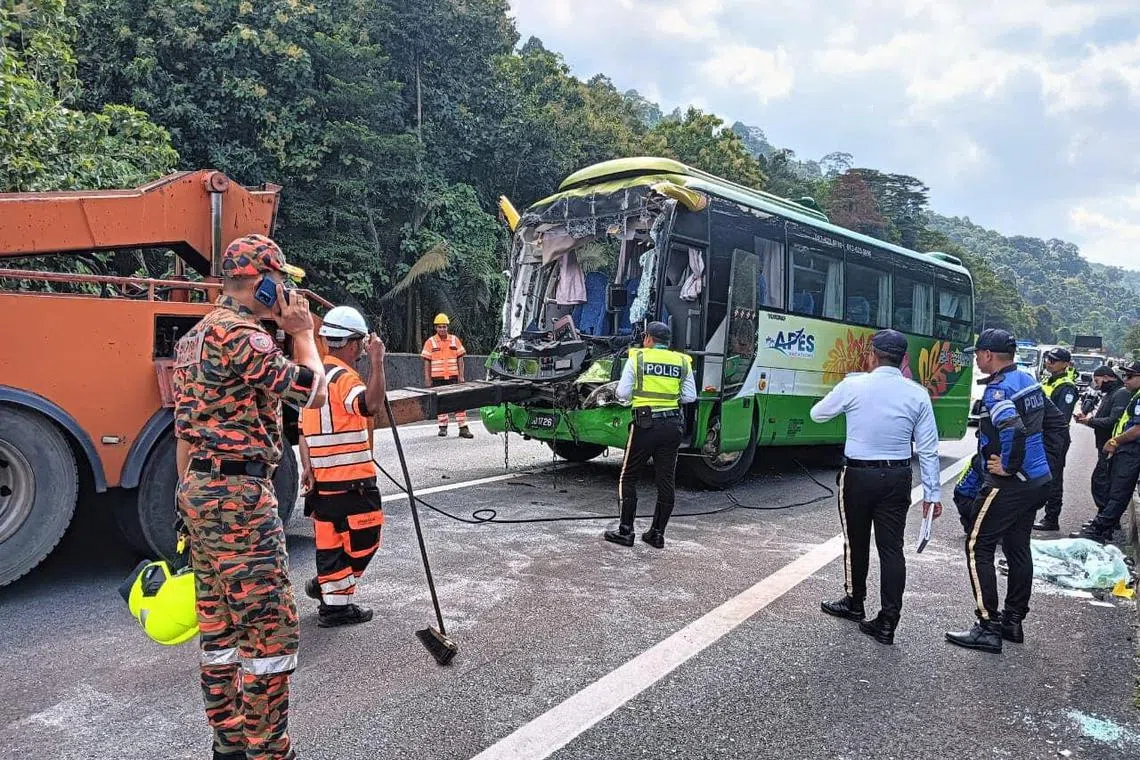AI may be used to detect accidents in real time in Malaysia
Sign up now: Get insights on the biggest stories in Malaysia

A firefighter and police officers at the site of a fatal road accident involving a bus in Taiping, Perak, on Oct 24.
PHOTO: REUTERS
Follow topic:
PETALING JAYA – The Malaysian Highway Authority (LLM) is mulling over the full adoption of the Automatic Road Incident Detection System (Arids), an artificial intelligence (AI)-based solution to detect road accidents in real time to reduce rescue response times on expressways.
Road safety expert Law Teik Hua said Arids, which is currently not used to its full potential, can facilitate quicker responses from first responders to accidents.
Dr Law, who is the head of the Road Safety Research Centre at Universiti Putra Malaysia’s (UPM) Engineering Faculty, said Arids – which was introduced in February – is in the pilot phase in areas covering a total of 1,000km of expressways and federal roads in Klang Valley and Kuching.
“However, Brunei and the provincial capital city of Xi’an in China have adopted the Malaysian-made system in their bid to make their roads safer,” said Dr Law.
“We have presented to LLM on the need to adopt it fully throughout Malaysia.”
When contacted, LLM director-general Sazali Harun confirmed that the authority is seriously considering the system’s full implementation.
“The UPM team, led by Dr Law, made the Arids presentation to LLM on Nov 15. The effectiveness of Arids will need further study by LLM before any decision is made,” Datuk Sazali said.
Dr Law, whose team developed Arids, said a fatal crash involving a container lorry in Simpang Renggam, Johor, on Nov 15 was detected by Arids at 7.46am that day.
“However, checks showed that the earliest official report from the North-South Expressway (Plus) Trafik X channel stated that the incident occurred at 8:09am,” said Dr Law, referring to expressway operator Plus Malaysia’s account on X.
“If the crash was detected earlier, rescue response time would have been cut shorter, with better survival rates.
“Most accidents on highways in Malaysia are attended to based on CCTV monitoring by the respective highway concessionaire, or reports from users or highway patrols.”
The authorities in Xi’an are using the incident-detection system on roads covering 200 traffic lights in a pilot run.
“Brunei has taken it and implemented it for its capital city to fully monitor traffic light junctions and also detect accidents and abnormalities,” said Dr Law, who is also a consultant with LLM, Kuala Lumpur City Hall and the police’s Federal Traffic Investigation and Enforcement Department.
With the core of the system based in Malaysia as a mobile traffic management system that allows remote access, Arids can be accessed using a mobile phone. It also runs continuously using Google traffic data to provide accident notifications as well as analyse traffic congestion data, including analysing whether traffic lights are functioning.
“The system detects accidents autonomously in real time as well as vehicle breakdowns and other traffic situations utilising neural networks (a type of machine learning process that is inspired by how humans learn),” said Dr Law, adding that Arids users can be automatically notified of anomalies via WhatsApp, without the need of any human input.
He said analyses of crashes on the system also showed the need for sturdier guard rails on highways, which currently can withstand the impact of only smaller vehicle crashes.
In response, West Coast Expressway (WCE) chief executive Lyndon Alfred Felix said that while crash prediction systems are continuously evolving, WCE has already implemented technology-driven solutions such as traffic monitoring systems and CCTV.
“These systems allow us to identify potential risks and patterns – such as erratic driving behaviour or excessive speed. WCE is also exploring advancements in predictive technologies,” he said, adding that the extent of enforcement is often dependent on coordination with the relevant authorities.
“The implementation of a weigh-in-motion (WIM) system will enable real-time monitoring of vehicle loads without requiring them to stop, thereby allowing the concessionaires to address issues related to overloading proactively,” said Mr Felix.
Quicker accident detection also needs to be paired with more stringent inspections of heavy vehicles, especially by concessionaires at the entry points of closed-toll networks.
Dr Law said current laws do not permit concessionaires to do this, thus the reliance on enforcement authorities.
Mr Sazali concurred, saying concessionaires have no legal authority to stop overladen lorries or unsafe vehicles from entering their networks.
“All vehicles are allowed to use highways or expressways except those restricted via restriction orders gazetted under the Road Transport Act, which also places WIM under the jurisdiction of the Transport Ministry,” he said. THE STAR/ASIA NEWS NETWORK

